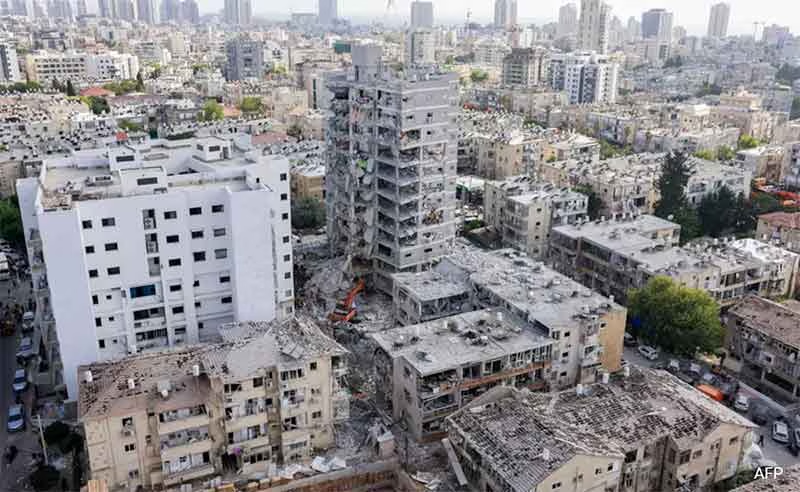
There once existed a city by the name of ‘Multicoloured city’. It had various houses built in it. People were encouraged to build houses as they deemed fit, to colour them with whatever colours they liked. So the houses in that city were all different…vibrant….with various shades of so many different colours. The residents of the city used to look at their city and be proud of it, proud of the freedom that they had, and for the choices that they had made – of turning the city into a multicoloured city. The residents of the neighbouring cities had no such freedoms.
When all these cities were united, in the ancient times, they had all had multicolored houses. All had stayed together happily and merrily in the same city. But then disaster struck, the ancient city was divided, and the neighbouring cities came into existence. The neighbouring cities chose to build themselves in a single colour. No variations were allowed. Even those who did-not like the chosen colour had to abide by the orders of the rulers and construct their houses in the defined colour. The residents of the multicoloured city used to feel sorry for their neighbours. But they were at the same time proud that they chose to continue as the multicoloured city. Their city had embraced the choices and freedoms of everybody and had in turn enriched itself. This city was the envy of the entire world for its values, ethos and culture.
There were some people in the city, however, who were not happy with the state of affairs. They did-not like that people could choose to build their houses in any colour that they liked. Their favourite colour was orange and they wanted each and every house to be of that colour. The people who were building their houses in green were especially detested by these people because the neighbouring cities had chosen green as the official colour in which their cities were to be built. These people, with orange as their favourite colour, considered the people who were building their houses in green colour as natural parts of the neighbouring cities. They felt that the rightful place of these people was in the neighbouring cities and not in this city. They were not ready to accept the fact that these people had chosen to stay back in this city because they did-not believe in the principle of a single colour but in the principle of co-existence of all the colours. These people, with orange as their favourite colour, were of the firm belief that the city should be actually called the Orange city and not the Multicoloured city, and that there was no place for construction of houses in any other colour in this city. The people whose favourite colours were different had to either abide by the orders of re-painting their houses in orange, or they would not be considered as the rightful residents of this city.
In the beginning, these people could-not convince enough residents of the multicoloured city to do away with their basic principle – of co-existence of all the colours. But slowly and gradually, things started changing. By various ways and means, it began to be established that the orange colour was the core of this city and the use of various colours was diminishing its value and centrality. A fear was created that a day might come when no orange coloured house will be visible in the city. People were convinced that by allowing people to construct houses in colours of their choice, some kind of injustice was being done with people who had orange as their favourite colour.
The people with orange as their favourite colour started becoming fearful. They felt that their favourite colour needs protection. The people with other colours as favourite had, after all, constructed whole cities in their favourite colours, however, no such option had been given to the people with orange colour as favourite. They were forced to co-exist with all the people having different colours as their favourites.
They thought that it was high time that the situation needed rectification. So they decreed that construction of houses in green colour was now forbidden. The people with orange as the favourite colour had been totally convinced by now and they wholeheartedly welcomed this move. Slowly, there were no houses in green colour that were visible in the city.
Once this was done, slowly and gradually same decree was passed against the construction of houses in any colour other than orange. A day finally came, when all the houses in the city were in orange.
The residents of the city had been very excited and had waited long for this day. They had thought that this day will bring with it an end to all their woes. The few people of the city who had been continuously warning these residents against their misconstrued notions had been made irrelevant long time back. The residents had sacrificed a lot for this day. They had struggled every single day on this journey, but had never lost their spirit. They were convinced by the honesty of their ideals. They were convinced that they were right in dreaming of an orange city. The dream had now materialized. The orange city – their Dream City – was alive, in flesh and blood.
The initial period after the birth of the orange city was full of celebrations. There was rejoicing and merriment all around. The sceptics who had been raising doubts all along had been proved wrong. There would be no place of any kind of grief now in this orange city.
Some amount of time thus passed. However, slowly and gradually, the initial exuberance started fading away. The struggles that had been sidelined by the residents till this day, while their sole focus was on the construction of the orange city, started rearing their heads. The problems that had existed all along now started looking bigger to the residents. There were some orange houses that were akin to palaces whereas some were not even close to shanties. A huge number of people stayed on the streets that were now painted in orange colour. The people were struggling to make ends meet. Their children had no opportunities to earn their livelihoods. The economy of the city was in the dumps.
The people were clueless now. Whom could they now blame for their deplorable condition? The people with all the other colours as their favourites were long back silenced or exterminated. The sceptics had been successfully shut out. The ultimate dream had been realized. Yet, why were they still struggling with their day to day livelihood issues, which had only worsened? The residents had no answer to this question. They were flummoxed. Now the thought of the colours of their houses did-not even occur to them. Looking at their orange coloured houses did not give them any comfort. They wanted work to do, food to eat and lives in which there was at least some amount of comfort. But they did-not know whom to look up to now. They also did-not know whom to blame for their condition.
Nivedita Dwivedi is a political commentator
SIGN UP FOR COUNTERCURRENTS DAILY NEWS LETTER










































